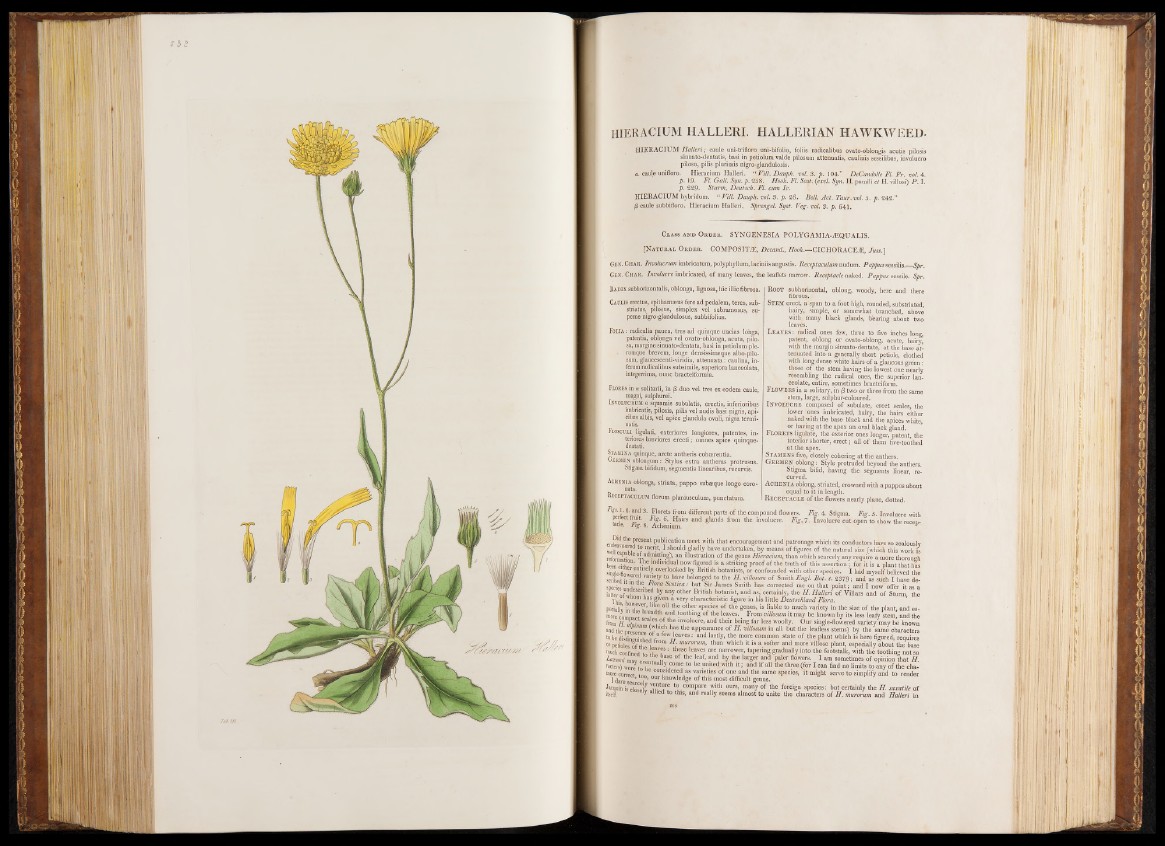
hieracium h a l l e r i . h a l l e r ia n h a w k w e e u .
HIERACIUM Halleri ;c tm \e uni-trifloro uni-bifolio, foliis radicalibus ovato-oblongis acutis pilosis
sinuato-dentatis, basi in petiolum valde pilosum attenuatis, caulinis sessilibus, involucro
piloso, pilis plurimis nigro-glandulosis.
a. caule unifloro. Hieracium Halleri. “ Fill. Dauph. vol. 3. p. 104.” DeCandolle Fl. Fr. ml. 4.
p. 19- Fl. Gall. Syn. p. 358. Hook. FI. Scat. (excl. Syn. H. pumili et H. villosi) P . I.
p. 329- Sturm, Deutsch. Fl. c.um Ic.
HIERACIUM hybridum. “ Fill. Dauph. ml. 3. p. 26. Bell. Act. Taur.ml. 5. p. 242.”
ß caule subbifloro. Hieracium Halleri.. Sprengel. Syst. Veg. ml. 3. p. 641.
Class a nd Ord e r . SYNGENESIA POLYGAMIA-AEQUALIS.
[Natural Ord e r . COMPOSITIE, Decand., Hook.—CICHORACEJE, Juss.l
GEN. Char. Inmlucrum imbricatum, polyphyllum, laciniis angusti
Gen. Char. Involucre imbricated, of many leaves, the leaflets r
. Receptaculum nudum. Pappus sessilis.—Spr.
rrow. Receptacle naked. Pappus sessile. Spr.
Radix subhorizontalis, oblonga, lignosa, hie illic fibrosa.
Caulis erectus, spilhamasus fere ad pedalem, teres, sub-
striatus, pilosus, simplex vel subramosus, su-
perne nigro-glandulosus, subbifolius.
Folia : radicalia pauca, tres ad quinque uncias longa,
patentia, oblonga vel ovato-oblonga, acuta, pilo-
sa, margine sinuato-dentata, basi in petiolum ple-
. rumque brevem, longe densissimeque albo-pilo-
sum, glaucescenti-viridia, attenuata: caulina, in-
ferum radicalibus subsimile, superiora lanceolata,
integerrima, nunc bracteiformia.
Floees in a solitarii, in ß duo vél tres ex eodem caule,
magni, sulphurei.
Involdceum- e squamis subulatis, erectis, inferioribus
imbricatis, pilosis, pilis vel nudis basi nigris, api-
cibus albis, vel apice glandula ovali, nigra termi-
natis.
Fiosculi ligulati, exteriores longiores, patentes, in-
teriores breviores erecti; omnes apice quinque-
deutati.
Stamina quinque, arete antheris cohserentia.
Germén oblongum: Stylus extra antheras protrusus.
Stigma bifidum, segmentis linearibus, recurvis.
Achenia oblonga, striata, pappo subasque longo coro-
nata.
Receptaculum florum planiusculum, punctatum.
Root subhorizorital, oblong, woody, here and there
fibrous.
Stem erect, a span to a foot high, rounded, substriated,
hairy, simple,, or somewhat branched, above
with, many black glands, bearing about two
leaves.
Leaves : radical ones few, three to five inches long,
. patent, oblong or ovato-oblong, acute, hairy,
with the margin sinuato-dentate, at the base attenuated
into a generally short petiole, clothed
with long dense white hairs of a glaucous green :
those of the stem having the lowest one nearly
resembling the radical ones, the superior lanceolate,
entire, sometimes bracteiform.
Flowers in a solitary, in (3 two or three from the same
stem, large, sulphur-coloured.
Involucre composed of subulate, erect scales, the
lower ones imbricated, hairy, the hairs either
naked with the base black and the apices white,
or having a t the apex an oval black gland.
Florets ligulate, the exterior ones longer, patent, the
interior shorter, erect; all of them five-t;oothed
at the apex.
Stamens five, closely cohering at the anthers.
Ge rmen oblong: Style protruded beyond the anthers.
Stigma bifid, having the segments linear, recurved.
Ach en ia oblong, striated, crowned with a pappus about
equal to it in length.
Receptacle of the flowers nearly plane, dotted.
1 I f ® 3- Florets from different parts of the compound flowers. Fig. 4. Stigma. Fig. 5. Involucre with
^neet tnut Fig. 6. Hairs and glands from the involucre. Fig. 7. Involucre cut open to show the recen-
racie. fig. 8. Achenium. ^
?rf Se0t Pub]ication meet witb that encouragement and patronage which its conductors have so zealouslv
...pil m m “Jer|t, I should gladly have undertaken, by means of figures of the natural size (which this work is
reformirinn n ■ ^ illustration of the genus Hieracium, than which scarcely any require a more thorough
been either 1 The individual now figured is a striking proof of the truth o f this assertion; for it is a plant that has
single flem-pf”?16 y- overlo1oked by British botanists, or confouuded with other species. I had myself believed the
scribed it in thpVaJJety ha.ve belonged to the H. villosum of Smith Engl. Bot. t. 2379; and as such I have de-
but. Sir James Smith has corrected me on that point; and I now offer it as a
latter of by any otber British botanist, and as, certainly, the H. Halleri of Villars and of Sturm, the
t. • . hom hfls given a very characteristic figure in his little Deutschland Flora.
peciallv hTh-hL H?iaU 0tl’-r spercif ?f the §enus>is liable t0 muGb variety in the size of the plant, and es-
more comnBPi Dreadtb a,’d-toothing of the leaves. From villosum it may be known by its less leafy stem, and the
from H H llY0,ucre> and their bein§ far less "’oolfy. Our single-flowered variety may be known
and the DrMpnrp H U hf S the aPPea[ance of H - villosum in all but the leafless stems) by the same characters
to be distinPuUl?pH>?JFe'v ‘eaves: and lastly> tb® ™ re. common state of the plant which is here figured, requires
or petioles of thp i« ni u murorum> than which it is a softer and more villose plant, especially about the base
much confinpH : th®se, leave® aie narrower, tapering gradually into the footstalk, with the toothing not so
Lawsoni mav p„p,!! Sase ° f the ,leaf’ and b7 the Iar§er and Paler flowers. I am sometimes of opinion that H.
meters') were 8 f"t y-,Com.e 10 be .unil'ed’vvltb lf 5 and lf ab the three (for I can find no limits to any o f the cha-
more correct inn,e Gonsiderfd as varieties of one and the same species, it might serve to simplify and to render
I daresc 1 knowledge of this most difficult germs. J
Jacquin is close] V t° . comPare with ours, many of the foreign species: but certainly the H. saxatile of
itself. y l,ea t0 th,3> and rea‘*y seems almost to unite the characters of H. murorum and Halleri in